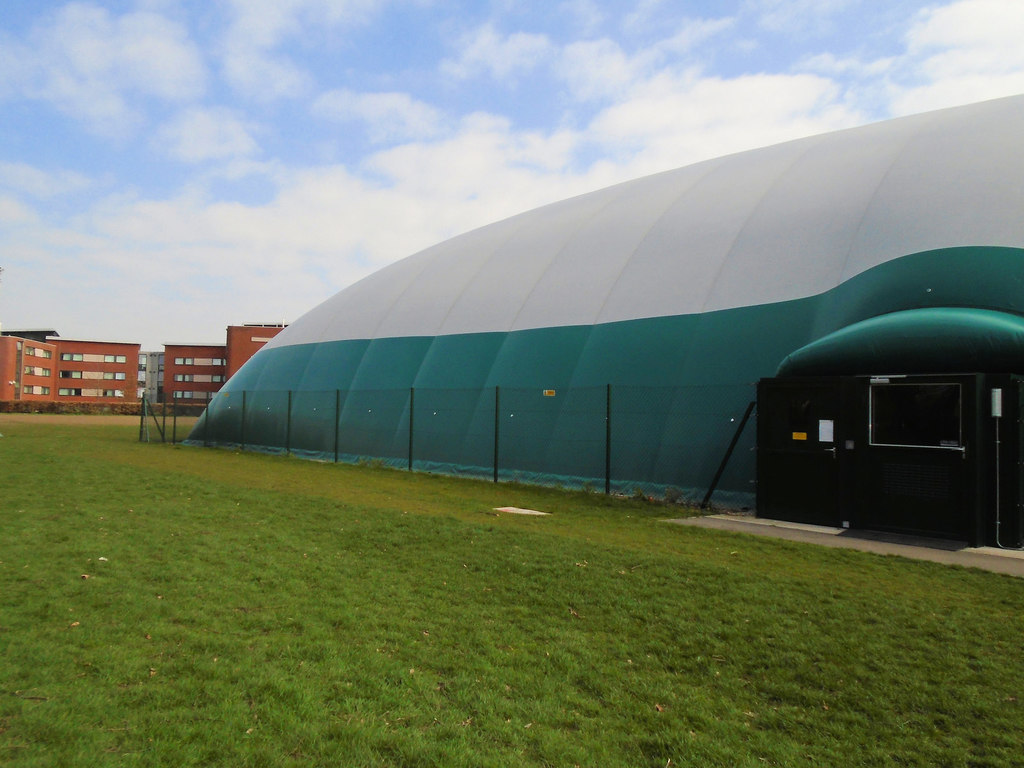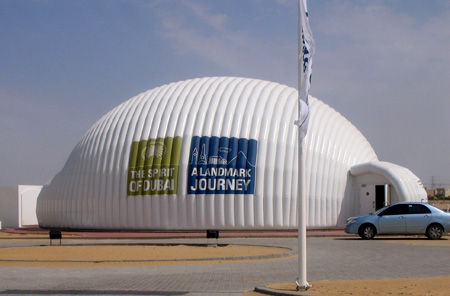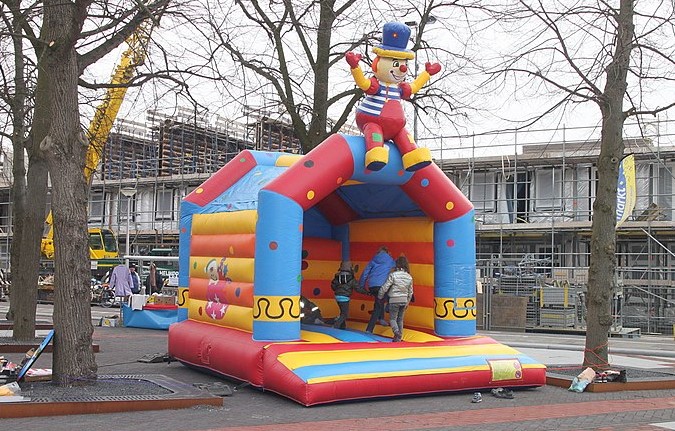Air-supported structure
Contents |
[edit] Introduction
An air-supported structure is held up by controlled internal air pressure rather than timber, concrete or steel supports. This type of structure is typically less expensive to construct than comparable traditional buildings and is capable of enclosing large areas with little internal structure and good natural lighting.
Air-supported structures are also sometimes called fabric dome structures or 'bubbles'. They are commonly shaped as ovals, hemispheres and half cylinders which can provide optimum pressurisation for the largest amount of space using the least amount of material.
[edit] History
In 1918 F.W. Lanchester patented a design for an 'air tent' in which it was proposed that a patterned balloon fabric could be inflated at a low pressure to form a habitable enclosure. In 1938, Lanchester developed the concept further with a design for an air supported dome spanning over 650 m. Such air supported and air inflated structures had many potential applications but in 1946 a mass market was identified, creating 'radomes', minimal structure shelters which provided climatic protection for radar dishes.
Following successful trials between 1946 and 1950, the radome concept was applied to the DEW line early warning system, and in 1953 Walter Bird established the company Birdair primarily for the manufacture of radomes. Since 1946 tens of thousands of radomes have been manufactured, some of the largest being more than 60m in diameter.
For more information see: The history of fabric structures.
The concept of the air-supported structure was further popularised by David H. Geiger when it was used for the United States pavilion at Expo 70 in Osaka, Japan. This structure was significantly less expensive than other proposed solutions and was designed to survive extreme weather conditions consistent with the Japanese climate. Based on its success, the air-supported fabric roof concept has been incorporated into numerous domed structures around the world.
[edit] Construction
Air-supported structures are often used to provide controlled climates for tennis courts, swimming pools, athletic fields, shelters, warehouses and so on. They may be temporary or permanent.
They are generally formed by a single-layer membrane that is supported by pressurisation of the air it encloses. Air loss when access points are opened is prevented by airlocks that maintain the level pressure inside the occupied space. However, the structure does not have to remain completely airtight in order to maintain pressurisation as long as a system is in place to adjust for leakage and provide stabilisation.
Because the air is trapped in the usable space inside the structure, the interior has a slightly higher air pressure than outside. This difference in pressure acts to stabilise the fabric enclosure of the building and does not have a noticeable impact on the people inside.
Further efforts to keep the material in place may include weights, anchors and cables.
Air-supported structures are typically made up of four components:
- Fabric membrane. This is often made from some type of coated synthetic material such as nylon that has been treated for weather and fire resistance. It may be interwoven with a network of strengthening cables made from steel or fabric. The inside of the membrane may include some form of acoustic material or other type of sound insulation.
- Pressurisation. Fans and HVAC equipment, along with sufficient emergency power provide suitable pressure and temperature control inside.
- Entry/exit access. Properly specified pressurised doors are necessary.
- Emergency supports. Some internal structure may be provided so that in the event of a loss of pressure there is still sufficient space to allow occupants to escape.
[edit] Air-supported structure vs air-inflated structure
Air-supported structures differ from air-inflated structures.
Sometimes referred to as inflatable buildings, air-inflated structures are constructed using two layers of membrane (as opposed to one) that are connected together to form inflatable 'cushions'. Membranes are usually less than 1 mm thick, and air is used to pressurise the cavity between them to form a 'rigid', structurally stable element, capable of spanning large distances.
Inflatable buildings can be portable, with the air allowed to escape before the membrane is packed down to a small volume. Inflatable structures (or inflatables) can also be used to create specific components such as escape slides, bouncy castles and so on.
[edit] Maintenance
Weather conditions tend to create the biggest challenges for air-supported structures. In climates where snow and ice are common, care must be taken to resolve issues that come with high loading. Manufacturers may provide different instructions to deal with snow removal on air-supported structures.
It is extremely unusual for an air-supported structure to experience sudden collapse. However, such an occurrence did take place in 2020 in Binghamton, New York. Once the largest air-supported dome in the United States, the Greater Binghamton Sports Complex collapsed after 104.14 cm (41 inches) of snow fell over a period of less than 24 hours.
Excessive wind conditions can also cause damage. However, some structures are designed to withstand winds as high as 120 mph.
Computerised controls are available for modern systems to monitor and compensate for air pressure and load variations automatically.
Other key maintenance concerns may involve the proximity of combustible materials such as vegetation, rubbish, chemicals or other hazardous substances.
If properly maintained, an air-supported structure can last between 10 and 15 years. It should be inspected regularly to check for deterioration or damage. Some fabric replacement or repair may be required intermittently.
[edit] Related articles on Designing Buildings Wiki
Featured articles and news
A change to adoptive architecture
Effects of global weather warming on architectural detailing, material choice and human interaction.
How big is the problem and what can we do to mitigate the effects?
Overheating guidance and tools for building designers
A number of cool guides to help with the heat.
The UK's Modern Industrial Strategy: A 10 year plan
Previous consultation criticism, current key elements and general support with some persisting reservations.
Building Safety Regulator reforms
New roles, new staff and a new fast track service pave the way for a single construction regulator.
Architectural Technologist CPDs and Communications
CIAT CPD… and how you can do it!
Cooling centres and cool spaces
Managing extreme heat in cities by directing the public to places for heat stress relief and water sources.
Winter gardens: A brief history and warm variations
Extending the season with glass in different forms and terms.
Restoring Great Yarmouth's Winter Gardens
Transforming one of the least sustainable constructions imaginable.
Construction Skills Mission Board launch sector drive
Newly formed government and industry collaboration set strategy for recruiting an additional 100,000 construction workers a year.
New Architects Code comes into effect in September 2025
ARB Architects Code of Conduct and Practice available with ongoing consultation regarding guidance.
Welsh Skills Body (Medr) launches ambitious plan
The new skills body brings together funding and regulation of tertiary education and research for the devolved nation.
Paul Gandy FCIOB announced as next CIOB President
Former Tilbury Douglas CEO takes helm.
UK Infrastructure: A 10 Year Strategy. In brief with reactions
With the National Infrastructure and Service Transformation Authority (NISTA).
Ebenezer Howard: inventor of the garden city. Book review.
Airtightness Topic Guide BSRIA TG 27/2025
Explaining the basics of airtightness, what it is, why it's important, when it's required and how it's carried out.
























